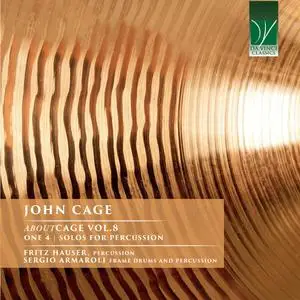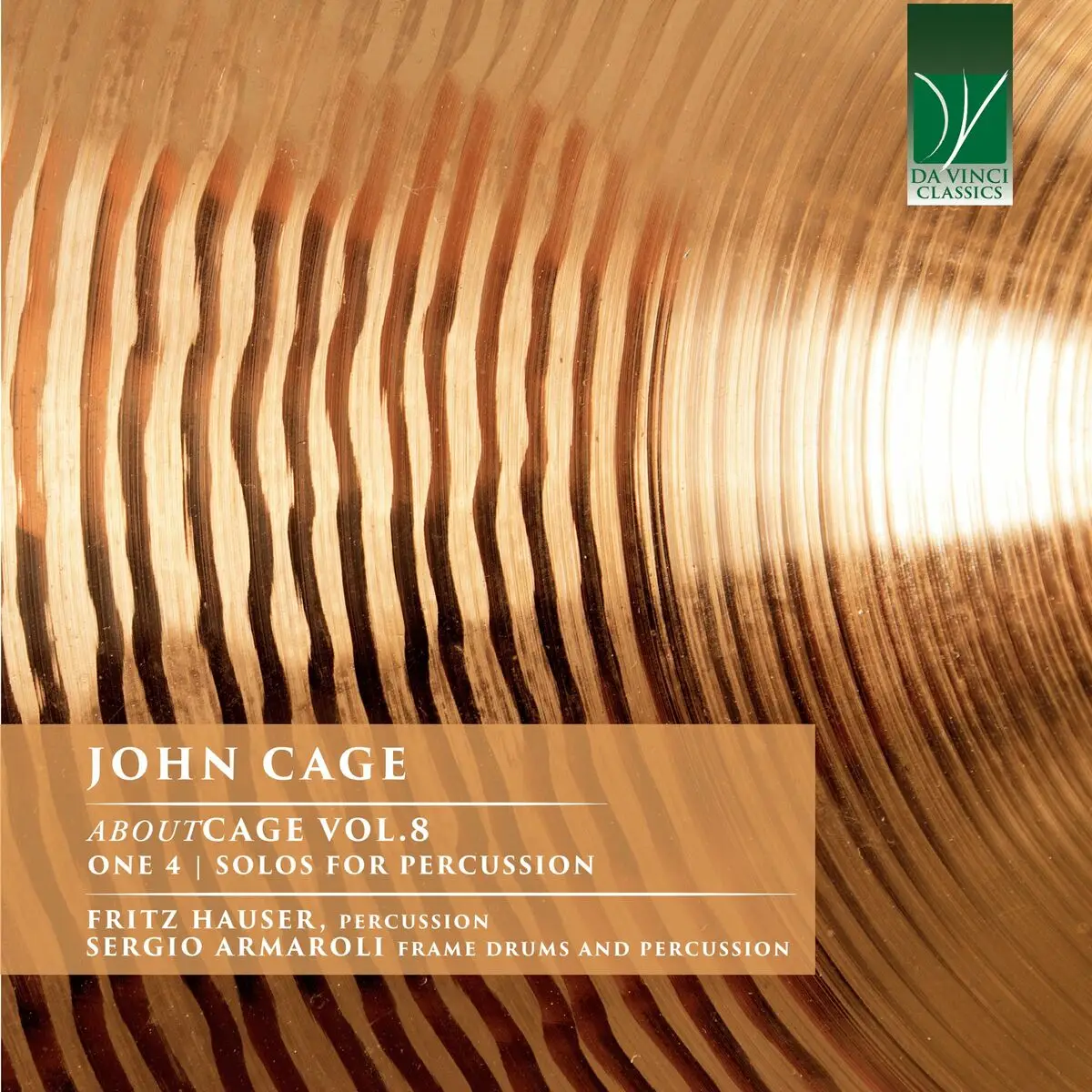Fritz Hauser - John Cage: AboutCAGE, Vol. 8 (ONE 4 | Solos for Percussion) (2023)
WEB FLAC (tracks) - 150 MB | Tracks: 5 | 57:08
Style: Classical | Label: Da Vinci Classics
WEB FLAC (tracks) - 150 MB | Tracks: 5 | 57:08
Style: Classical | Label: Da Vinci Classics
It is rather common for music lovers to turn the radio on as soon as they start the engine of their cars. And it is equally common, for those steeped in the Classical music tradition, to amuse themselves trying to guess which work (or at least which composer) is being played when they find themselves in the midst of a piece. What is at work, in such a game one plays with oneself, is musical memory (in the attempt to connect a known tune or passage with something one remembers, and to give it a label), knowledge of a composer’s style, knowledge of the musical style of a particular historical period. When a given theme matches the listener’s inner archive of known music, then the game is won.
No such game could be possible with any of the pieces recorded here. Indeed, the impossibility of such a game is demonstrated specifically by this Da Vinci Classics album, which includes two different versions (by Sergio Armaroli and Fritz Hauser respectively) of One4. It is patent, to anyone listening to these two versions of the “same” piece, that no superficial likeness can be found between the two versions, whereas, for instance, two versions of a Chopin Nocturne played by two different pianists will normally be immediately recognizable as being “the same piece”.
Still, Armaroli and Hauser do not fail to respect the composer’s indications; they are following Cage’s prescriptions no less carefully than pianists do with Chopin’s score. The point is that there is a dramatic difference between a Chopin and a Cage score, and this determines the completely different kind of approach one has to adopt.
The works recorded here have in common a penchant for chance processes, graphical scores, guided improvisation, in varying degrees and proportions. Cage was deeply drawn by the idea of de-personalizing the process of composition. In open polemics against the Romantic, subjectivist approach (music as the expression of the self), he aimed at a music which was non-expressive, and unbound to the individual and to personality.
The first piece in this programme has a number as its title: 27’ 10.554” for a percussionist (1956). As with other pieces by Cage (most notably the famous and celebrated 4’ 33”), the number stands for the piece’s duration. Here again we find a difference with “traditional” Classical music: whilst two performances of the same piece will normally have roughly the same duration, there are many exceptions, and, especially if one observes performances dating back from the beginning of the twentieth century, comparing them with more recent ones, at times the difference may be striking. With Cage, instead, the superficial appearance of the piece (i.e. how it sounds, which sounds are produced, what timbre they have) will differ drastically between two given renditions of 27’ 10.554”, while the duration must be exactly (or almost exactly) the same.
This piece is the last of an unfinished series written by Cage between 1953 and 1956. The collection should have comprised pieces for various ensembles or soloists, and it is possible to play each piece individually or to superimpose two or more of them. The first recording of some of these pieces, in fact, included the superimposed performance of several (five) of these works.
Together, these pieces number 100 phrases of 100 beats each, adding up to a total of 10,000 beats. This number has a particular meaning, for Cage but not only for him. In the Chinese tradition, it represents multiplicity (i.e. the world, what exists and surrounds us) as it pours forth from unity. This principle is expounded in a poem/aphorism by Lao Tzu, found in The Way of Lao Tzu, i.e. in the book Tao Te Ching:
“Tao produced the One. / The One produced the two. / The two produced the three. / And the three produced the ten thousand things”.
Whilst Cage did not call this collection so, the name The Ten Thousand Things almost unavoidably sticked itself to the works it comprises, and so they are commonly referred to today. The pieces dovetail with each other in terms of structure, number of bars etc.; this happens also to the piece recorded here, whose form is the same as that of the three pieces written before it. There are five sections, whose proportions are based on prime numbers; each section comprises 28 units made by 5 phrases each.
The percussionist is called to choose the instrumentation to employ, provided that at least one instrument is chosen for each of the four categories prescribed by Cage: M (metal), W (wood), S (skin) and A (all others). Within these broad fields, the performer is free to select what means of sound production will be used, in which order and how they will be played. Cage recommends that playing techniques be “exhaustive rather than conventional”, i.e. he calls for a broad-minded and original exploration of the sounds which may be created by those instruments. It is equally possible to use recordings, partially or entirely.
The score consists of the superimposition of four “staves”, each representing one of the categories. Each of the published score’s 28 pages stands for one minute of music, divided into shorter units; each stave symbolically and rather abstractly represents the production of sounds on a given sound medium. The notation employed by Cage is doubtlessly reminiscent of traditional Western notation (indeed, it is based on a pre-understanding of the rules of traditional notation), but, at the same time, it eschews all references to the prescriptiveness of a traditional score.
The musical materials (one should rather say “raw matter”) for these staves come from chance operations derived by Cage from the I-Ching, in particular asking the I-Ching for responses as regards the choice between sound and silence at a given moment, the duration of sounds and of silences, the quantity of events in the sounding phrases, the actual production (or lack thereof) of a specific sound, and the kind of musical event which will happen.
And just as the imperfections on the paper on which music is written must be taken into account as part of the notation, rather than as mere disturbances, so are the chance sounds produced, for instance, by the audience, during one of the piece’s long silences, which may be as long as one minute at times.
This piece, therefore, is a prime example of “composed improvisation”, since the guidelines for performance are clearly defined by the composer, but, at the same time, the actual aural appearance of the piece, its audible incarnation, its sensory embodiment, will be determined entirely by the performer. And for this reason there can be no two performances which display some likeness to each other.
“Composed improvisations” are also those recorded as the following numbers in this album. These works, both dating from 1990, have a double “c” in their title (“cComposed”), whereby the first “c” stands for the composer’s name. It is in fact an improvisation, but one closely led and guided by the composer.
By giving much freedom to the player, Cage wished to create a room for their own creativity, an opportunity for their fantasy to come to the fore. In 1951, Cage had written to Pierre Boulez: “I freed myself from what I had thought to be freedom, and which actually was only the accretion of habits and tastes”. Here, the two cComposed Improvisations represent a meaningful realization of Cage’s principles in terms of compositional and performing freedom.
Both cComposed Improvisation No. 2 and No. 3 were first written in 1987 and then taken over again in 1990 for their completion. Both also exist in other versions, i.e. for Steinberger Bass Guitar, One-Sided Drums With or Without Jangles, and Snare Drum Alone. Each score comprises two pages, detailing performance elements; in each, two fixed time brackets surround a third, which is variable; each of them contains some events, from one to sixty-four; chance operations will determine the number of events which will be actually played.
The second cComposed Improvisation is dedicated to Stuart Smith, whilst the third to Glen Velez.
Finally, there is One4, written in 1990 too, i.e. two years prior to the composer’s death. Here again he employs time brackets; in this case six of them are provided for the solo percussionist’s left hand, and eight for the right. Here, however, just one note is found in each of these time brackets, so that the piece in its entirety comprises just fourteen sounds. This piece has been dedicated to Fritz Hauser by the composer, and therefore it is particularly touching to listen to a version of this piece elaborated and performed by the dedicatee, who also premiered it in January 1991. The piece’s title, which might be puzzling, shares the same generative principle with the other “Number pieces” (the title is apocryphal but commonly adopted). The number written in full (One, in this case) refers to the number of players needed, while that written as a digit (4) represents the order of composition of that particular piece. So, One4 is the fourth piece for one player in the series.
Together, the works recorded in this production offer us an informative and interesting panorama on how Cage intended composition, notation, improvisation… These concepts, which are fundamental for the Western musical tradition, are dramatically reinterpreted by the composer, offering us new insights into the practices of music-making.
Chiara Beertoglio
Tracklist:
01. 27'10.554 for a Percussionist (Version by Fritz Hauser)
02. Composed Improvisation No.3, for One-Sided Drums With or Without Jangles (Version by Sergio Armaroli)
03. Composed Improvisation No.2, for Snare Drum Alone (Version by Fritz Hauser)
04. One4 (Version by Sergio Armaroli)
05. One4 (Version by Fritz Hauser)
FILE: 01. 27'10.554 for a Percussionist (Version by Fritz Hauser).flac
Size: 68937698 Hash: 3867181943876845BDBE62457872A12F Accuracy: -m0
Conclusion: CDDA 100%
Signature: 9D2D878DB200AD8E5466A90E11834DE03D248551
FILE: 02. Composed Improvisation No.3, for One-Sided Drums With or Without Jangles (Version by Sergio Armaroli).flac
Size: 19476922 Hash: 8C3F7787CE0C0635377571AC3FDB45F6 Accuracy: -m0
Conclusion: CDDA 100%
Signature: FC02BD4EA99D062FFA362BCAFBFE0E1FBC7A007C
FILE: 03. Composed Improvisation No.2, for Snare Drum Alone (Version by Fritz Hauser).flac
Size: 30595571 Hash: C3A7E07CB58E6D0A779E8976A7243420 Accuracy: -m0
Conclusion: CDDA 100%
Signature: F95D93D8981240B4BA95895A59E7F486182A4F1E
FILE: 04. One4 (Version by Sergio Armaroli).flac
Size: 207363 Hash: 0706F9B57A41254E8D5C21DBA955D75B Accuracy: -m0
Conclusion: CDDA 100%
Signature: C46D08D1797E1E62D8D745545B92448D2EC1F4D3
FILE: 05. One4 (Version by Fritz Hauser).flac
Size: 38834868 Hash: F5CD67981796A9ABED57B225C2376FDE Accuracy: -m0
Conclusion: CDDA 100%
Signature: CE7A45983DB9C0A0AF6DF23C0331283BAA9A4B7B



